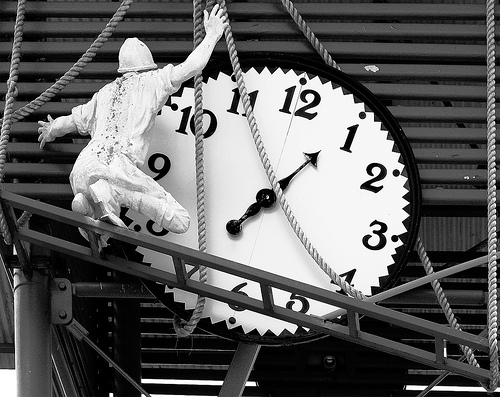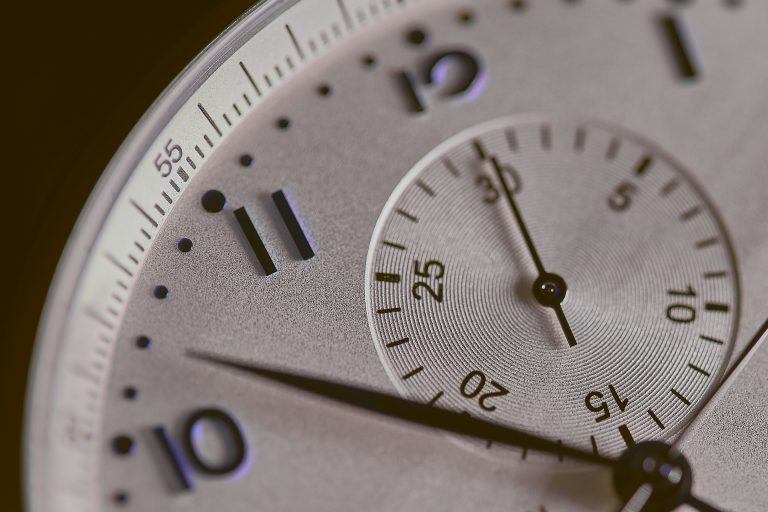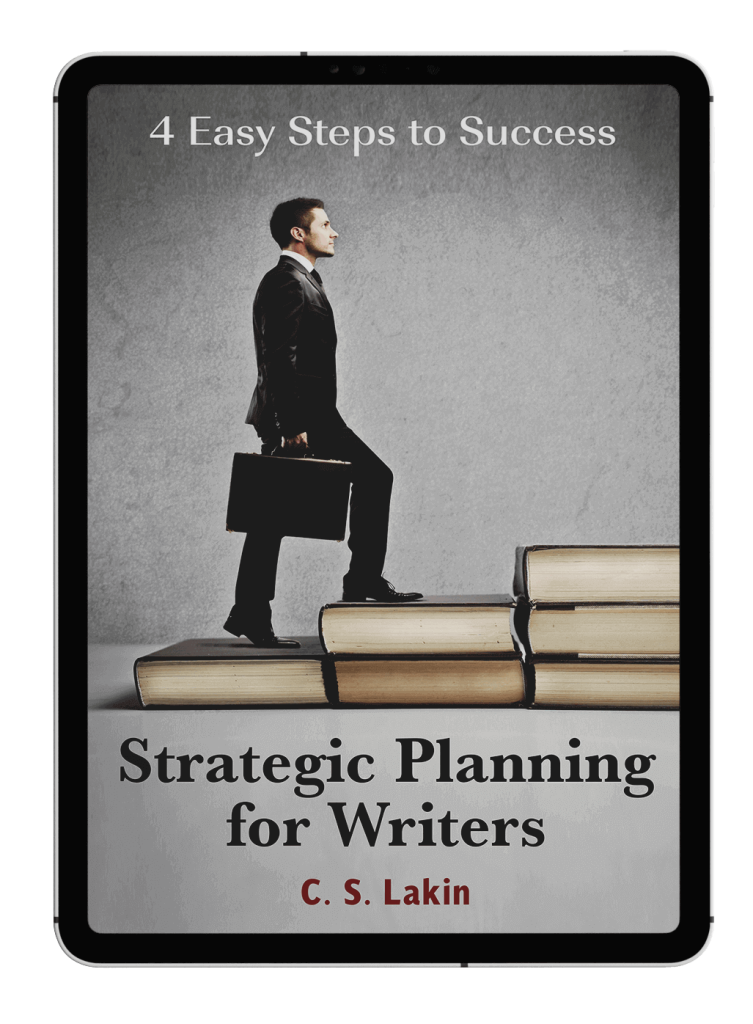How Fiction Writers Can “Speed Up” Time
Last post I discussed ways fiction writers can manipulate time. Meaning, give the illusion that, for the POV character (and for the reader), time seems to be speeding up or dragging. Writers can skillfully manipulate time in many ways, even creating skewed time (which we’ll explore in the next post).
Writers can utilize cinematic technique when it comes to conveying the sense of time passing. In films, it’s much easier to visually portray time movement. A few camera tricks, such as fast-forwarding film or slowing it down, clearly conveys that.
But it’s a little trickier for writers to create the same effect using only words on a page.
So how can a writer give a sense of time speeding up? One way is to use clipped sentences and short words. If you show a character’s attention zipping from one thing to another, never able to focus long on anything, that’s one way to speed up time.
To him, everything seems to be zooming around him. People are talking too fast for him to understand; chaos is reining around him. News hits him without giving him a chance to breathe.
We know what an adrenaline rush feels like in an emergency situation—how the heart pounds and blood races in our ears. Writers can use the character’s internal and external impressions to create a sense of quickened time.
This is the opposite of what we looked at in the previous post, regarding time that drags. When time speeds by, no one is going to notice the bubbles rising to the surface of a pot of water.
Here’s an excerpt of a highly intense sequence from the novel Shibumi, by Trevanian. This scene goes on for pages and pages, and yet, probably only a few minutes of “actual” time passes for his main character, Hel.
Because he may die at any moment and has to think quickly and be smart in order to survive, time feels as if it’s zooming by, out of his grasp.
Here’s the situation: Hel finds himself trapped in an underground cavern where he and his close friend were spelunking. The bad guys have not only killed his friend but sealed the only exit out of the cave. Hel’s only option is to venture madly into the underground river cutting through the “Wine Cellar” in the hopes it will suck him down and through to freedom outside the mountain.
He has his scuba tank and dive mask and some other supplies with him, for they had come down here hoping to explore this river.
But he has no idea if any navigable wide-enough egress exists. With his faceplate now cracked and his jaw broken from a fall, his last flare sputters out, throwing him into darkness that closes in on his mind “with a crushing weight.”
Pay attention to how Trevanian uses these series of quick images, speeding up at the end of the passage as Hel’s desperation grows and his air diminishes. By doing so, the author creates a clear sensation of how time is passing for Hel.
He took a deep breath and braced his nerves, remembering how that current had snatched away the dye packets so quickly that the eye could not follow them.
Almost leisurely, his body floated toward the bottom of the sump pit. That was his last clear image.
The current gripped him, and he shot into the pipe. His foot hit something; the leg crumpled, the knee striking his chest; he was spinning; the flashlight was gone; he took a blow on the spine, another on the hip.
And suddenly he was lodged behind a choke stone, and the water was roaring past him, tearing at him. The mask twisted, and the faceplate blew out, the broken pieces cutting his leg as they flashed past. He had been holding his breath from fear for several seconds, and the need for air was pounding in his temples. Water rushed over his face and eddied up his nostrils. It was the tank! He was wedged in there because the space was too narrow for both his body and the tank!
He gripped his knife with all the force of his body focused on his right hand, as the water sought to twist the knife from his grasp. Had to cut away the tank! The weight of the current against the cylinder pressed the straps against his shoulders. No way to slip the knife under He must saw through the webbing directly against his chest.
White pain.
His pulse throbbed, expanding in his head. His throat convulsed for air. Cut harder! Cut, damn it!
The tank went, smashing his foot as it rushed out under him. He was moving again, twisting. The knife was gone. With a terrible crunching sound, something hit the back of his head. His diaphragm heaved within him, sucking for breath. His heartbeat hammered in his head as he tumbled and twisted in the chaos of foam and bubbles.
Bubbles . . . Foam! He could see! Swim up! Swim!
For a man struggling in a dangerous situation, perhaps about to lose his life, how would time feel in passing? Every second might feel like a minute. But time is not dragging, is it? It’s racing by. He’s actually running out of time.
If the author covered this mere few moments in just three sentences, do you think readers would get a sense of this tense perception of time?
What Tevanian does here to heighten the suspense of this action sequence is he draws out the minute details. Hel is experience every fraction of every second, so in a way, to the reader’s perception, time is moving agonizingly slowly.
Doesn’t that seem like a crazy paradox? We’ve often sat in movie theaters biting off all our nails as a character is trapped inside a house and trying to get out, and we’re urging her to hurry, hurry, to get out of danger. To us, it’s taking forever to get to safety. But to the character being chased by a killer, time might be racing, slipping from her grasp.
Here’s an excerpt from a fantasy book by Roger Zelazny called The Guns of Avalon, the second book of the five-book Amber series—a favorite of mine.
In Zelazny’s world, the princes and princesses of Amber, the true world, can create and move through fabricated (shadow) worlds that are only reflections and variations of the true Amber. In order to move through one world to another, these characters have to alter the world they are in one piece at a time by willing the change. They see in their minds what they want to shift, and the world is effected in response.
Zelazny paints a wild canvas of imagery that literally goes on for pages, taking the reader on something akin to a video-game experience as his protagonist, Corwin, shifts his world around him to get to the one he strives for.
Notice how time seems to pass quickly as images race by:
I turned and continued southward, confirmed in my desire to succeed. Amber I do not forget . . .
The sun became a dazzling, bright blister above my head and the winds began to scream about me. The sky grew more and more yellow and glaring as I rode, until it was as if a desert stretched from horizon to horizon overhead. The hills grew rockier as I descended toward the lowlands . . .
Then long shadows, the dying of the wind, stillness . . . Only the click of hood on rock and the sounds of breathing . . . Now a rippling, glassy curtain to my right as the rain advances . . . Blue fracture lines within the clouds . . . The temperature plummeting, our pace steady, the world a monochromatic backdrop now. . .
Gonging thunder, flashing white, the curtain flaring toward us now . . . two hundred meters . . . One-fifty . . . Enough!
It’s bottommost edge plowing, furrowing, frothing . . . The moist smell of the earth . . . Star’s whinny . . . A burst of speed.
Small rivulets of water creeping outward, sinking, staining the ground . . . Now bubbling muddily, now trickling . . . Now a steady flow . . .
And on it goes. But the effect of the endless short images creates just the feel Zelazny is going for. Those choppy incomplete sentences give the sense of time zooming by, and this technique is called a montage in film terminology.
This is one great way to manipulate time in scenes of high danger and stakes.
In my novel Intended for Harm, Jake is driving his car, and his young son Joey is pointing, telling him to turn. Jake ignores him; that’s not the way home. Then . . .
A loud crash startled Jake, caused him to shoot a look back at Joey, but all he could see was a flash of light, blinding, that made Jake not only whip his head back around but swing the wheel hard in Joey’s direction, to the right, to where his son’s finger still pointed, Joey holding it in the air like an exit sign, an escape from the cascade of crashes and loud explosions of noise that seemed to erupt all around him.
Jake’s vision cleared enough for him to see a curb, a sidewalk, and an opening alongside it where he could pull over, which he did, fitting his car into the space, the only one, on the right of the wide boulevard, then Jake realized he was still in the middle of the huge intersection, but off to the side, his tires edged up against the center divider, with lanes of vehicles on both sides of him, facing two directions, but no one moving. Jake’s head rang as he willed his hands to stop shaking, put the stick shift into Park, set the brake.
He swung his head back; Dinah’s mouth formed an O, no sound coming out, and Joey staring out the driver’s side window, staring at something, his expression unreadable but alarming.
Jake turned to see what snagged Joey’s attention. He rubbed his hand in circles on the fogged-up glass, then threw the door open, because he could not believe what he saw.
Like the aftermath of some explosion, cars and trucks askew, smashed into others, metal and glass strewn over the asphalt, one car upended and a wheel still spinning. Jake gripped his open door, his attention drawn to a loud cry, then to another truck—smashed head on against the brick wall running the length of the street, perpendicular to traffic. People staggered out of vehicles, stood dazed under the traffic lights that kept faithfully changing from green to yellow to red and back to green again with no one heeding.
The sounds that had been ringing muted in his ears suddenly burst into a loud cacophony, as time sped up and the reality faced him down, cars honking and people shouting, and Jake surveying and counting at least eight vehicles totaled, maybe more, and now the rain exploding in a downpour, and the wheel of that one car still spinning in a slow wobbly circle, round and round, in mesmerizing mindlessness.
The technique of using a stream of consciousness like this allows writers to amplify the sensory details and throw them at the reader one after another. Jake sees in broken imagery—a curb, a sidewalk, followed by a realization that he’s in the middle of an intersection. He jumps from one slight action to another, showing his fierce focus on just what’s in front of him: a center divider, putting the car in Park, setting the brake.
Yes, I did have my character notice that “time sped up” to bring Jake back into some semblance of normal time, but I hope I showed how that plays out as Jake gathers his wits and notices the downpour of rain and the wheel spinning wobbly.
Adrenaline kicks us into heightened awareness at times like these. For some people time moves extremely slow instead of racing, and they notice everything—every dust mote, every nuance of sound.
Have you ever tried to manipulate time like this? Think of a place in your story where you need time to speed up or slow down. These techniques will work!
Featured Photo by Alex Perez on Unsplash










